A few days ago, I wrote about
10 strategies for rhythmic reading and writing, in hopes of giving you ideas for your year plan. Today I will blog about 10 strategies for melodic reading and writing! As in the last blog post, some of the ideas I will describe in this blog post, some will link to other blog posts, and some will link to freebies and other products. Here goes!
#1: Ghost Melodies
In
this blog post, I wrote about how to do ghost melody composition on dry erase boards. This is a great precursor to having students listen for and begin writing specific pitches, like sol and mi.
#2: Staff writing
In
this blog post, I wrote about how to introduce the staff to first graders. You could use chips (
math counting chips work well because they are see-through, and students can see the line running through the note) or you could use cute seasonal erasers like I did in the blog post.
#3: Whole group stick to staff
Once students can sing from stick notation patterns (with only rhythm and solfa written underneath the rhythm) and staff notation patterns, they can begin to see the connection between the two. Here is a freebie I posted for help with transferring stick to staff for sol-mi (just click the picture to be taken to the download!)
#4: Small group stick to staff
Once students have worked as a whole group transferring stick notation to the staff, they can work in small groups to do the same. The above picture was taken while students were working with my
Penguin Stick-to-Staff set for low sol; students had to work with the small group to match up the stick notation patterns with the corresonding staff notation patterns. It was so cool to hear their conversations about why cards matched or didn't match!
#5: Dulcimers
Playing dulcimer can be a great way for students to transfer their knowledge of solfa to an instrument! You could put the staff notation or stick notation for "Hot Cross Buns," for example, on the board, show them where do is, and see if they can figure out how to play it on their dulcimers! My students are using cardboard dulcimers in this picture; you can purchase them
here, and see my set below.
#6: Recorder tic-tac-toe
Speaking of instrument playing, I love this game by Amy Abbott from Music a la Abbott! Students can play in teams, see the staff pattern, play it on their recorders, and try to collect points! The interactivity of the powerpoint is really cool--after they play the pattern, you can click X or O, and watch it appear on the tic-tac-toe grid. Anytime you can make a game out of building a skill is a great opportunity for improving their learning! Click the picture to see the product.
#7: Sight reading
To have students sight read a melody, you could just have them try singing through it...but unless they have lots of experience, it might fall apart! I often go through this process for sight reading, whether from stick notation or from the staff:
- Read the rhythm with syllables
- Speak the solfa (I have heard that some people think that solfa should never be spoken, but speaking from experience, this is a good way to get students to understand how the solfa fits with the rhythm!)
- Inner sing the melody: Give students a starting pitch and have them do the hand signs, singing inside their heads
- Sing the melody aloud
Going through this process really seems to help break down the sight-reading into manageable steps and helps them be successful!
#8: Solfa manipulatives
In
this blog post, I wrote about using solfa manipulatives with my students. I LOVE to use these as a precursor to writing or reading on the staff, and to really target their inner hearing. They also work really well as an assessment during whole group or centers!
#9: Hand staff
Having students use their hands as a staff is a very helpful way for them to kinesthetically understand lines and spaces on the staff. To use the hand staff, I have students look at the inside of their hands, and point to their pinkies for the first line, ring finger for the second line, etc. The first space can be between their pinky and ring finger. You could have them sing solfa while pointing to the correct spots on their hand staff. You could also do the hand staff incorrectly and see if they can figure out the mistakes!
#10: Poison Patterns for Preparation and Practice
I just posted this fun set for playing melodic poison during preparation AND practice. Poison is one of my students' favorite games, and with this set you can project on your SMART board, white board, or print out the cards. Click on the picture to see the product.
Which strategies do you like for melodic reading and writing? Comment below, and happy teaching!










































MENU SOCIAL LINKS